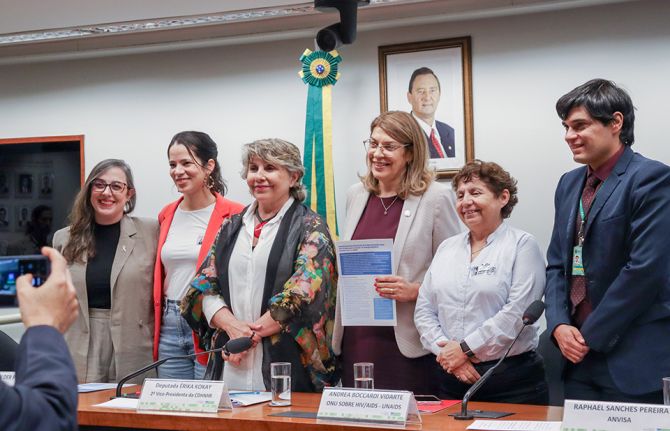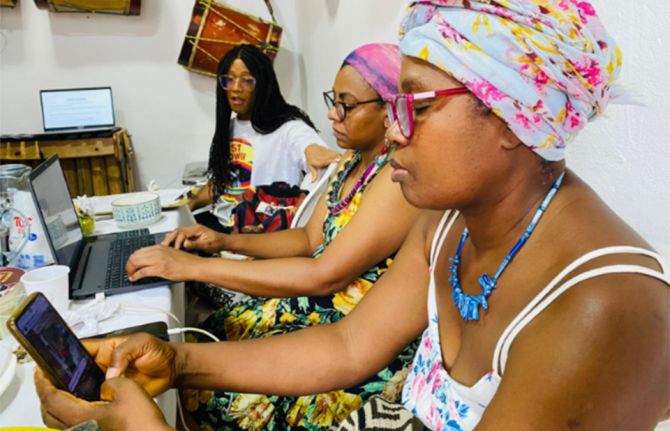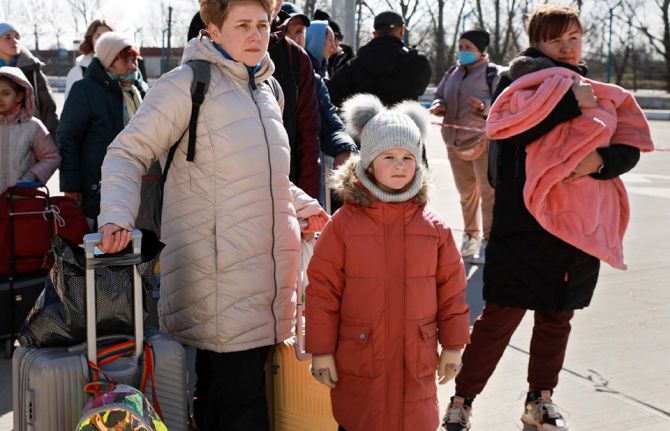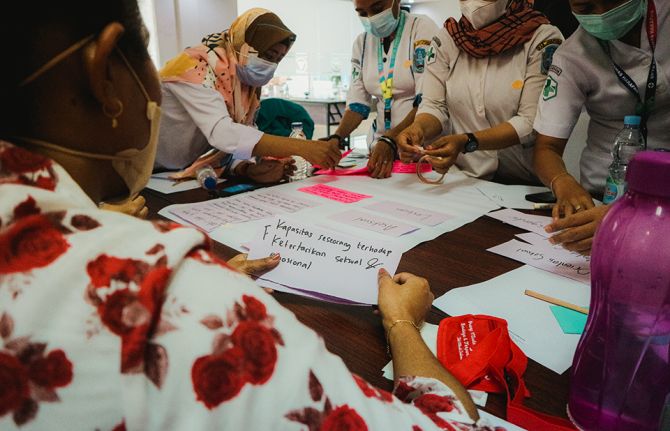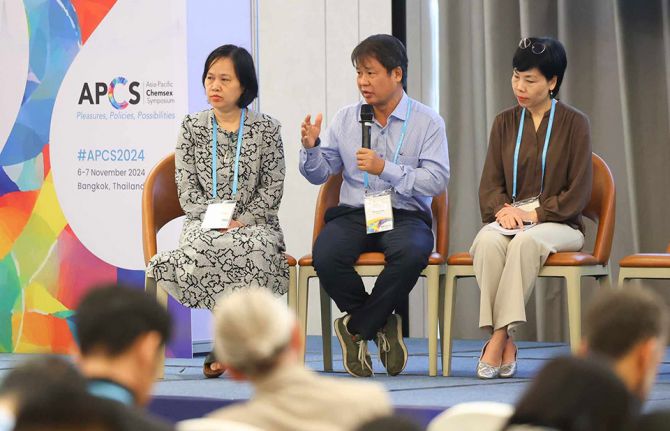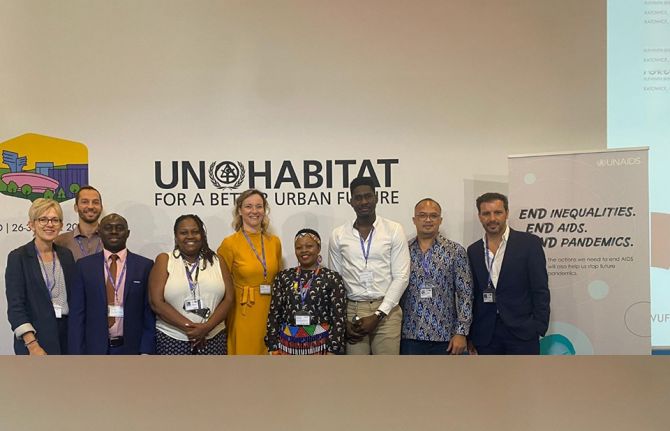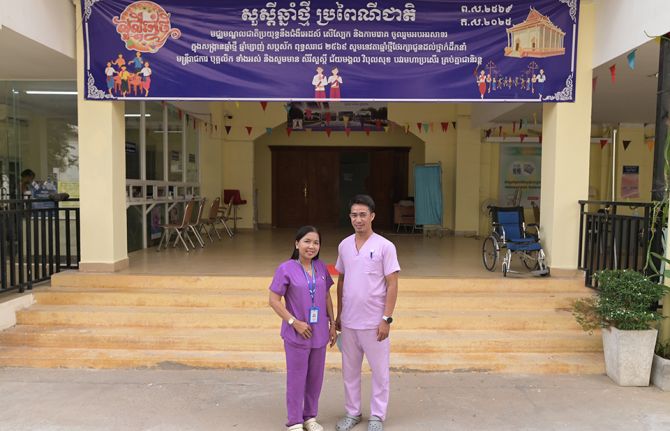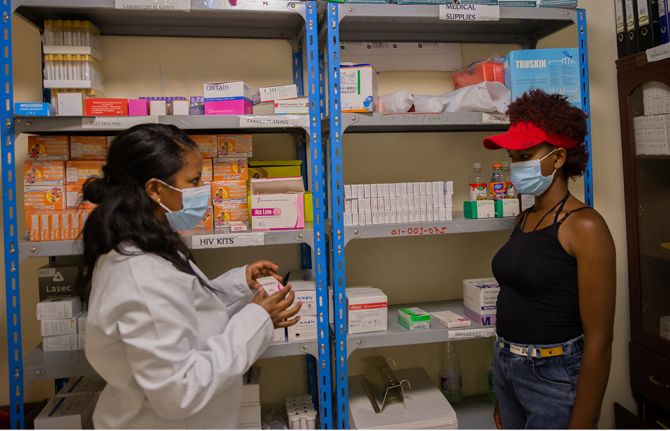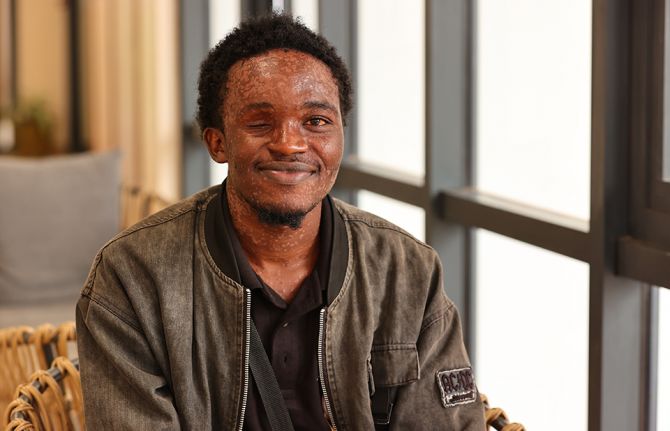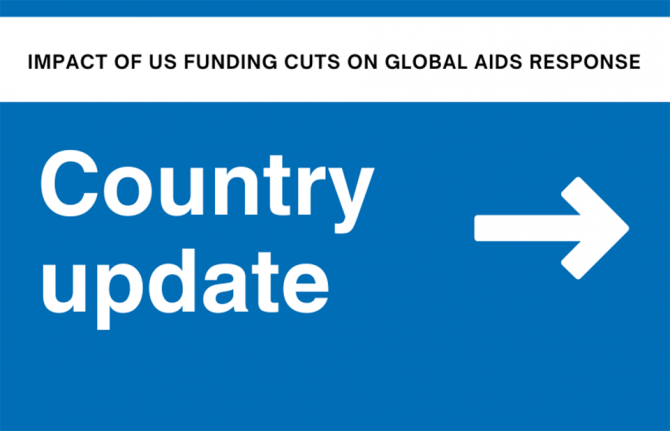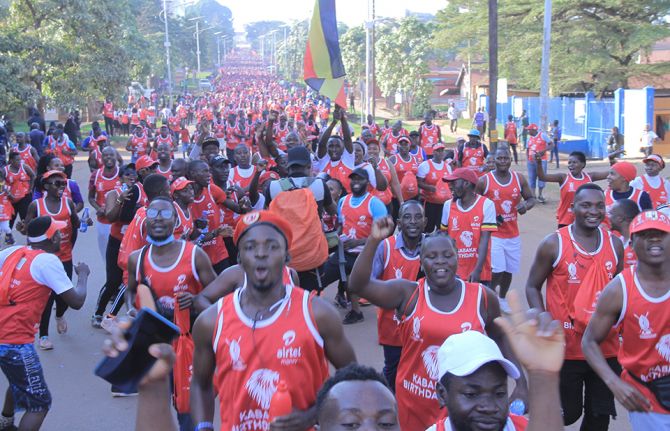
Feature Story
Brazilian national Lesbian, Gay, Bisexual and Trans Association awarded consultative status to the UN
28 July 2009
28 July 2009 28 July 2009
The United Nations Economic and Social Council (ECOSOC) has for the first time awarded consultative status to a Latin-American non-governmental organization representing the rights of lesbian, gay, bisexual and transgender communities. The organization, the Brazilian national Lesbian, Gay, Bisexual and Trans Association (ABGLT), will now be able to present oral and written reports at UN meetings and organize events on UN premises.
The ABGLT has said that its primary goal will be to highlight injustices around the world faced by the lesbian, gay, bisexual and transgender community, particularly in the 80 countries in the world have legislation that prohibits same sex behaviour.
UNAIDS welcomes the decision by ECOSOC and fully supports the rights of the lesbian, gay, bisexual and transgender community. UNAIDS works closely with such organizations in the AIDS response and will continue to promote human rights and fundamental freedoms for people living with HIV and those more vulnerable to HIV infection.
Brazilian national Lesbian, Gay, Bisexual and Tra
Feature stories:
ECOSOC adopts resolution on UNAIDS (27 July 2009)
ECOSOC high level forum discusses global public health progress and challenges (06 July 2009)
External links:
ECOSOC
The Brazilian Gay, Lesbian, Bisexual, Transvestite and Transexual Association (ABGLT)

Feature Story
Public-private partnerships strengthen health systems and AIDS response
27 July 2009
27 July 2009 27 July 2009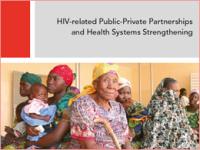
“Phones for Health” is a partnership between a healthcare software provider Voxiva, a phone producer Motorola, a telecom company MTN, the GSMA Development Fund, PEPFAR, CDC Foundation, Accenture Development Partnerships and several governments. The integration of mobile technology and health applications enables health workers on the road to input and transfer health data to a central database where the data can be analysed. In addition, they can order medicines, send alerts, download guidelines, or access training materials.
This is one of several public-private initiatives showcased in a new UNAIDS report that looks at the contribution of AIDS-related public-private partnerships* to the six building blocks of health systems: service delivery; human resources; information; medicines and technologies; financing; and leadership.
HIV-related Public-Private Partnerships and Health Systems strengthening, highlights how the AIDS response has been a strong catalyst in the establishment of public-private partnerships for health, particularly in Africa. Many of these partnerships initially focused on HIV but they later expanded to cover wider health issues.
We hope the report will provide some guidance on critical steps private and public actors need to take to maximize the potential of public-private partnerships for the benefit of public health.
Regina Castillo , UNAIDS Private Sector Partnerships Chief
“This publication is innovative as it approaches public-private partnerships via a very specific angle: their applicability to strengthen the public sector,” said UNAIDS Private Sector Partnerships Chief, Regina Castillo. “We hope the report will provide some guidance on critical steps private and public actors need to take to maximize the potential of public-private partnerships for the benefit of public health,” Ms Castillo added.
UNAIDS has noted in its Outcome Framework 2009-2011 that substantial progress on a number of the Millennium Development Goals can be achieved by taking the AIDS response out of isolation and integrating it with efforts to achieve broader human development including the goal of health.
Research and interviews with representatives of private and public organization stakeholders as well as development partners were carried out. Twelve public-private partnerships with a strong collaborative relations with government institutions in the country of implementation were identified to present insider perspectives on catalysts and hurdles which may be encountered in developing collaborations. Good practices have been identified taken into consideration their sustainability, their integration in the national AIDS control plan, their measurable results, etc.
Some of the partnerships presented in the publication include North Star Foundation, BD’s Wellness Centres relieving the pressure on nurses in sub-Saharan Africa, DataDyne and Vodaphone Foundation developing health surveys with EpiSurveyor, Abbott Fund’s laboratory support from national to regional level in Tanzania, Mars supporting the National Health Insurance Scheme of Ghana, Fondation Sogebank managing Global Fund grants as Principal Recipient in Haiti, etc.
The topic of public-private partnerships was the focus of a breakout session of the Thematic Segment of the 23rd UNAIDS Programme Coordinating Board Meeting in Geneva on 15 December 2008. UNAIDS governing board then commissioned the Secretariat to compile “best practices and lessons learnt to support and facilitate public-private partnerships with respect to their applicability for strengthening the public sector in low and middle income countries”. “HIV-related Public-Private Partnerships and Health Systems Strengthening” is the result from this process.
To receive printed copies of the report, please contact Marie Engel, email engelm@unaids.org
* A Public-Private Partnership is defined as an “institutional relationship between the state and the private profit and/or the private non-profit sector, where the different public and private actors jointly participate in defining the objectives, methods and implementation of an agreement of cooperation”.
Public-private partnerships strengthen health sys
Contact:
Marie Engel
Email: engelm@unaids.org
Publications:
HIV-related Public-Private Partnerships and Health Systems Strengthening (pdf)
Joint Action for Results: UNAIDS Outcome Framework 2009-2011 (pdf, 396 Kb.)
Related

Feature Story
ECOSOC adopts resolution on UNAIDS
27 July 2009
27 July 2009 27 July 2009
Credit: ECOSOC
The UN Economic and Social Council (ECOSOC) passed a resolution on UNAIDS by consensus at its 2009 substantive session on 24 July. Negotiations on the text were led by the Delegation of the Netherlands, in its capacity as Vice Chair of the UNAIDS Programme Coordinating Board and ECOSOC member, and 31 countries – from all regions – co-sponsored the text.
The resolution welcomes the UNAIDS Outcome Framework as a tool for achievement of the goal of universal access and its emphasis on the prevention of sexual transmission. Moves to leverage AIDS to respond to broader health and development agendas, in particular the health Millennium Development goals (MDGs) – through the removal of socio-economic and legal barriers, and the maximum use of flexibilities under the TRIPS agreement to provide access to affordable antiretroviral drugs of assured quality – were applauded as central to the mandate of UNAIDS.
ECOSOC urged all member states to eliminate HIV-specific restrictions on entry, stay and residence, and for all stakeholders to come together at the country level to develop transparent, accountable and effective national responses within the “Three Ones” principles. Ongoing financial and political support for research and development of prevention technologies – including an effective HIV vaccine – was needed.
Recognition was also given to the need for the Joint Programme to significantly expand and strengthen its work to address the gap in services for injecting drug users in all settings. Barriers to the response continue and partnerships in addressing them will be key – as outlined in the welcome UNAIDS Action Framework: Universal Access for Men Who Have Sex With Men and Transgender People.
In recognizing the interrelated nature of the health and gender-related MDGs, Member States welcomed the ongoing development and operationalization of an Action Framework addressing women, girls, gender equality and HIV, under the leadership of the UNAIDS Executive Director.
At country level, efforts were encouraged to strengthen the UNAIDS technical support division of labour, and the concept of a joint United Nations team and programme on AIDS, with the aim of harmonizing technical support, strengthening programmatic coherence and improving the collective accountability of the United Nations system. UNAIDS ongoing role in the process of UN reform, and in the delivery of broader United Nations development assistance – was recognized and encouraged.
Finally, ECOSOC welcomed the submission by Member States of a total of 147 country progress reports in 2008, as part of the reporting process established by the Declaration of Commitment n HIV/AIDS, which had provided the most comprehensive overview to date of the response at country level, and encouraged all Member States to fully support the next round of reports due on 31 March 2010.
ECOSOC adopts resolution on UNAIDS
Feature stories:
ECOSOC high level forum discusses global public health progress and challenges (06 July 2009)
External links:
Publications:
ECOSOC resolution E/2009/L.23 (pdf, 30.1 Kb.)
Report of the Executive Director of the Joint United Nations Programme on HIV/AIDS (UNAIDS). Prepared in response to Economic and Social Council resolution 2007/32, in which the Council requested the Secretary-General to transmit to it at its substantive session of 2009 a report.
Joint Action for Results: UNAIDS Outcome Framework 2009–2011 (pdf, 396 Kb.)
UNAIDS Action Framework: Universal Access for Men Who Have Sex With Men and Transgender People (pdf, 323 Kb.)
Related

Feature Story
Dialogue on Universal Access Report 2009 released
23 July 2009
23 July 2009 23 July 2009 (from left) Norwegian AIDS Ambassador Sigrun Mogedal and Michel Sidibé, UNAIDS Executive Director
(from left) Norwegian AIDS Ambassador Sigrun Mogedal and Michel Sidibé, UNAIDS Executive Director Credit: UNAIDS
When the Executive Director of UNAIDS took office he called for a renewed commitment to universal access. From January to May 2009, a transition team led by Norwegian AIDS Ambassador Sigrun Mogedal engaged in a process of consultations and dialogue with key partners and stakeholders in the HIV response to obtain insight on where UNAIDS should focus its efforts in helping countries achieve universal access to HIV prevention, treatment, care and support.
More than a thousand people were consulted in this extensive exercise, from Programme Coordinating Board (PCB) members, UNAIDS Cosponsors, to The Global Fund to Fight AIDS, TB and Malaria, civil society partners, including people living with HIV, the private sector and foundations.
Ambassador Mogedal fostered open dialogue during the transition. For her enormous contribution I am very grateful. The information gathered by the Dialogue process gives valuable insights to the organization as we move forward
Michel Sidibé, UNAIDS Executive Director
“Ambassador Mogedal fostered open dialogue during the transition. For her enormous contribution I am very grateful,” said Michel Sidibé, UNAIDS Executive Director. “The information gathered by the Dialogue process gives valuable insights to the organization as we move forward,” he added.
The wide consultative process enabled invaluable exchanges of opinions. The report Dialogue on Universal Access 2009 highlights the main findings and proposes a number of areas of focus and recommendations for UNAIDS to lead a more effective AIDS response.
The information gathered from the consultations became a primary source of inputs for the UNAIDS Outcome Framework: Joint Action for Results 2009–2011, which provides guidance for Cosponsors and the Secretariat.
Visit the e-Dialogue website to access weekly discussions, resources and consultation documentation,
Dialogue on Universal Access Report 2009 released

Feature Story
HIV Treatment data update – July 2009
23 July 2009
23 July 2009 23 July 2009An estimated 4 million people in low- and middle-income countries were receiving antiretroviral therapy (ART) at the end of 2008, compared to 3 million in 2007 and 400,000 in 2003, according to preliminary data compiled by WHO, UNAIDS and UNICEF. Approximately 285,000 children benefited from paediatric ART programmes in 2008, a 45% increase over the prior year. In sub-Saharah Africa, nearly 3 million people were accessing treatment in 2008, a 38% increase over 2007.
These and other figures—presented at the International AIDS Society conference in Cape Town—are based on an analysis of data collected from 127 low- and middle-income countries. In collaboration with countries, WHO, UNAIDS and UNICEF are still completing the analysis. Final figures on ART access will be published in the September 2009 "Towards Universal Access" progress report, together with an in-depth analysis of a broad range of health sector HIV/AIDS interventions.
Substantial progress has been made in increasing access to treatment in low and middle income countries. Some countries have already achieved their universal access goals for treatment. However in other countries, the rate of scale up is not sufficient to achieve their national targets for 2010.
Some of the factors hindering progress include weak and fragmented health systems that are not sufficiently decentralized, poor integration of health services, poor access to HIV testing and counselling services, pervasive stigma and discrimination. These constraints are further affected by the recent economic crisis. WHO, UNICEF and UNAIDS together with partners and implementers, are working on responses for countries to overcome the obstacles.
"Towards Universal Access" is an annual report that monitors the health sector response to HIV/AIDS. To access the 2008 report, please visit the following link.
HIV Treatment data update – July 2009
Related

Feature Story
Evidence shows new drug combination dramatically reduces mother-to child transmission of HIV during breastfeeding
22 July 2009
22 July 2009 22 July 2009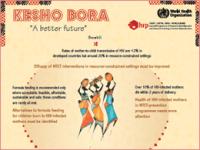
Credit: WHO
According to a new study led by the World Health Organization (WHO), if HIV-positive pregnant women are given a combination of antiretroviral (ARV) drugs from late in pregnancy until six months into breastfeeding, rather than a short course of drugs that ends at delivery, their babies are over 40% less likely to become infected with HIV.
The initial findings of the study, named Kesho Bora, which means ‘a better future’ in Swahili, were presented at the 5th International AIDS Society Conference on HIV Pathogenesis, Treatment and Prevention taking place in Cape Town, South Africa, 19-22 July. WHO worked in partnership with the French National Agency for Research on AIDS and Viral Hepatitis (ANRS), the US Centers for Disease Control and Prevention (CDC) and Eunice Kennedy Shriver National Institute of Child Health and Human Development (NICHD) of the US National Institutes of Health.
Carried out between June 2005 and August 2008, involving 1,140 women at five sites across Africa (in Burkina Faso, Kenya and South Africa), the purpose of Kesho Bora was to assess whether the risk of passing on HIV during breastfeeding could be reduced.
It shows that a significant reduction in infant infection can be achieved when pregnant women with a CD4 immune cell count of 200-500 cells/ mm3 are given a combination of three ARVs to prevent transmission: starting in their last trimester of pregnancy, continuing through birth and six months of breastfeeding. This was shown to reduce the risk of transmitting HIV to the baby and improved survival compared with babies of mothers with HIV who are given the current WHO-recommended short-course ARV regimen in late pregnancy and around the time of delivery.
The best results in the study were recorded in the group of mothers enrolled with a CD4 count between 200 and 350 cells/mm3. There is no increased risk to the health of the mother or the infant associated with this triple-ARV regimen, consisting of zidovudine, lamivudine and lopinavir/ritonavir. The study did not randomize women with CD4 counts below 200 cells/ mm3 as these women require treatment for their own health. That treatment also substantially reduces the risk of transmitting HIV during breastfeeding.
The issue of breastfeeding is a crucial one for pregnant women living with HIV. In many developing nations they have a tough choice: either breastfeed their babies and risk transmitting the virus through their milk, or give them formula. The latter deprives infants of the natural immunity passed on through breast milk which helps protect against diarrhoea, malnutrition and other potentially deadly diseases. Sanitation can also be an issue, with a scarcity of clean water with which to mix the formula and, in any case, many may not be able to afford to buy it in the first place.
Preventing mothers from dying and babies becoming infected with HIV is one of the nine priority focus areas for UNAIDS and its Cosponsors under the Joint action for results: UNAIDS outcome framework 2009-2011.
Michel Sidibé, UNAIDS Executive Director, has championed this priority and said during a recent visit to Lesotho in Southern Africa, “Strengthened services for maternal health, for reproductive health and for paediatric health will mean we can prevent mothers from dying and babies from becoming infected with HIV in Lesotho and around the world.”
The findings from the Kesho Bora study will now be considered by WHO experts, along with other recent data, and the 2006 WHO recommendations on the use of ARVs in pregnant women and on infant feeding and the prevention of mother-to-child transmission will be reviewed in the context of this new evidence. Updated guidelines are expected to be published before the end of the year.
It is clear that this research increases the range of treatment options available to mothers living with the virus and offers them hope that, if they so wish, they have a greater chance of breastfeeding their babies without passing on HIV.
Additional funds for the Kesho Bora study were provided by the European and Developing Countries Clinical Trials Partnership, the Thrasher Foundation, the UK Department for International Development, UNICEF and the Belgian Government.
Evidence shows new drug combination dramatically
Cosponsors:
Feature stories:
Lesotho: HIV free babies bring hope (16 July 2009)
Better HIV diagnosis in mothers and infants to avoid death from TB vaccine (03 July 2009)
Dispatch from the field: WHO HIV Director tours pioneering treatment clinic in Namibia (01 July 2009)
Early diagnosis and treatment save babies from AIDS-related death (27 may 2009)
External links:
WHO's Department of Reproductive Health and Research — information on the Kesho Bora study
Publications:
Joint Action for Results, UNAIDS Outcome Framework, 2009–2011 (pdf, 396 Kb.)
Antiretroviral Drugs for Treating Pregnant Women and Preventing Infections in Infants: Towards Universal Access. Recommendations for a Public Health Approach (2006 version) (En | Fr)
Conclusions of the WHO expert consultation on new and emerging evidence on the use of antiretroviral drugs for the prevention of mother-to-child transmission of HIV, 17-19 November 2008, Geneva, Switzerland
(pdf, 67.7 Kb.)
Consensus Statement on HIV and Infant Feeding by the Inter-Agency Task Team on Prevention of HIV Infections in Pregnant Women, Mothers and their Infants, October 2006 (En | Fr)
United Nations agencies' HIV and Infant Feeding Framework for Priority Action (En | Fr)
Related

Feature Story
Young researcher from Kenya recognized at 5th IAS Conference
21 July 2009
21 July 2009 21 July 2009
The International AIDS Society (IAS) and its partners have announced this year’s winner of the Young Investigator Prize: Women, Girls and HIV.
This year’s recipient is Dr Linnet N. Masese, Kenya, for her abstract, A prospective cohort study of the effect of antiretroviral therapy on sexual risk behaviour in a high-risk cohort of Kenyan women. It was selected by a review committee from eligible abstracts submitted to and accepted for presentation at IAS 2009.
The award will be presented to Dr Masese during the 22 July Plenary of IAS 2009 by the President of the International AIDS Society, Dr Julio Montaner, UNAIDS Chief Scientific Adviser Dr Catherine Hankins.
The prize was launched in 2006 and is awarded to a female investigator from a low-income or middle-income country whose abstract demonstrates excellence in research and/or practice that addresses women, girls and gender issues related to HIV.
Dr Linnet N. Masese completed her medical degree at the University of Nairobi, Kenya in 2003. She received a Master’s degree in Public Health (Epidemiology & International Health) from the University of Washington in Seattle, USA in 2008.
Dr. Masese currently serves as the Clinic Section Head at the University of Nairobi/University of Washington Mombasa Field Site. She is supported through the Fogarty International Center through an Advanced In-Country Scholar appointment awarded by the UW’s International AIDS Research and Training program. In this capacity, she is leading two studies entitled “Extending the durability of first-line therapy: a pilot study of directly administered antiretroviral therapy” and “Vaginal Health: An Innovative Behavioral Approach to Decrease HIV/STI Transmission”. In September 2009, Dr. Masese will begin her studies as a pre-doctoral trainee in the UW’s PhD program in Epidemiology.
The US$2,000 prize is jointly funded by the IAS, the IAS Industry Liaison Forum, and UNAIDS, and supported by the International Center for Research on Women and the International Community of Women Living with HIV/AIDS.
The IAS Conference on HIV Pathogenesis, Treatment and Prevention is the world’s largest open scientific conference on HIV. IAS 2009 is taking place in Cape Town, South Africa until 22 July 2009.
Young researcher from Kenya recognized at 5th IAS

Feature Story
Deputy President of South Africa echoes UNAIDS priorities at international AIDS conference
20 July 2009
20 July 2009 20 July 2009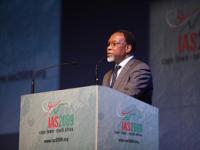
South Africa’s Deputy President Kgalema Motlanthe addresses opening of IAS 2009
Credit: International AIDS Society / Simon Deiner / SDR Photo
The Deputy President of South Africa, Kgalema Motlanthe has pledged to strengthen work on eliminating mother to child transmission of HIV.
His declaration came during his welcoming address at the opening session of the 5th IAS Conference on HIV Pathogenesis, Treatment and Prevention, taking place in Cape Town, South Africa from 19-22 July.
The Deputy President said that the importance of eliminating mother to child transmission of HIV was reinforced to him during his meeting with the Executive Director of UNAIDS, Michel Sidibé with whom he had met just three days earlier in Pretoria.
The two men met whilst Mr Sidibé was on an official visit to South Africa to highlight some of the key priority areas he urged South Africa to focus on in the coming years.
 (from left) Mr Michel Sidibé, UNAIDS Executive Director; Dr Aaron Motsoaledi, Minister of Health of the Republic of South Africa and Mr Kgalema Motlanthe, Deputy President of the Republic of South Africa and Chair of the South African National AIDS Council after a meeting in Pretoria, South Africa on 16 July 2009.
(from left) Mr Michel Sidibé, UNAIDS Executive Director; Dr Aaron Motsoaledi, Minister of Health of the Republic of South Africa and Mr Kgalema Motlanthe, Deputy President of the Republic of South Africa and Chair of the South African National AIDS Council after a meeting in Pretoria, South Africa on 16 July 2009. Credit: UNAIDS/G.Williams
The meeting took place just a day after the Executive Director had visited the paediatric ward of the Queen Elizabeth II hospital in Maseru, Lesotho where staff were caring for children born with HIV. An experience which Sidibé described as “a sad realisation of how much still needs to be done to prevent mothers living with HIV from transmitting the virus to their babies”.
The Deputy President said that during the meeting they had agreed that South Africa must ensure that it dramatically decreases the number of infants that are infected so that it can have a generation free from HIV.
Mr Sidibe has championed preventing mother to child transmission of HIV as one of UNAIDS nine priority areas which have been recently defined in a “Joint Action for results: UNAIDS Outcome Framework”
Deputy President of South Africa echoes UNAIDS pr
Feature stories:
Lesotho: HIV free babies bring hope (16 July 2009)
Multimedia:
Webcast of the opening session
Welcome address from the Deputy President of South Africa
External links:
Related

Feature Story
Lesotho: HIV free babies bring hope
16 July 2009
16 July 2009 16 July 2009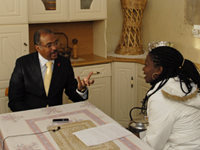
Michel Sidibé chats with Ms Pitso of mothers2mothers
Credit: UNAIDS/G. Williams
“Strengthened services for maternal health, for reproductive health and for paediatric health will mean we can prevent mothers from dying and babies from becoming infected with HIV in Lesotho and around the world,” said Mr Michel Sidibé, UNAIDS Executive Director.
Strengthened services for maternal health, for reproductive health and for paediatric health will mean we can prevent mothers from dying and babies from becoming infected with HIV in Lesotho and around the world,
Michel Sidibé, UNAIDS Executive Director
Mr Sidibé was speaking during his official visit to Lesotho which ended with a visit to the children’s ward and mother and child health section of the Queen Elizabeth II hospital in Maseru. He was accompanied by the Minister of Health Dr Mphu Ramatlapeng.
Mr Sidibé earlier was welcomed into the home of Ms Pitso a HIV-positive mother who thanks to access to services for the prevention of mother-to-child transmission gave birth 11 months ago to her baby boy Emlyn who is free of HIV. Mr Sidibé listened to Ms Pitso’s hopes for a bright future for her son. Mr Sidibé has championed the prevention of babies from becoming infected with HIV as a priority for UNAIDS and its Cosponsors.
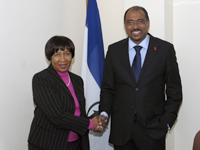
Lesotho Minister of Health and Social Welfare Dr Mphu Ramatlapeng (left) meets Michel Sidibé, executive director of UNAIDS.
Credit: UNAIDS/G. Williams
Lesotho has made progress in coverage of prevention of mother-to-child transmission services for pregnant women, up from 5% in 2006 to 42% in the first quarter 2009. Without any intervention, an HIV positive pregnant woman’s chances of passing HIV to her baby are 30-40%. Infection transmission is the highest during pregnancy and delivery, but also during breastfeeding, especially if breast milk is mixed with other feeding. With the provision of a comprehensive prevention services, the transmission rate can be reduced to less than 2%.
“Lesotho is a model in its achievements, particularly in the field of preventing mother to child transmission of HIV,” said Mr Sidibé.
At the Queen Elizabeth II hospital, Mr Sidibé also acknowledged the contribution and commitment of health care workers. Addressing staff shortages in health and social sectors has been an aim of the Government of Lesotho who in partnership with the UN have developed an emergency human resources strategic plan, which includes ways of attracting, training and retaining health personnel.
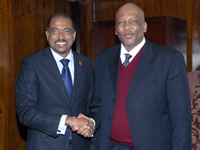 His Majesty, King Letsie III (right) and UNAIDS Executive Director Michel Sidibé. Maseru, Lesotho. 15 July 2009
His Majesty, King Letsie III (right) and UNAIDS Executive Director Michel Sidibé. Maseru, Lesotho. 15 July 2009Credit: UNAIDS/G. Williams
His Majesty, King Letsie III hosted a meeting yesterday with the Executive Director. Mr Sidibé also met with and Prime Minister Pakalitha Bethuel Mosisili-Qhobosheaneng, members of Lesotho’s national AIDS Commission, and other senior government officials.

Michel Sidibé, executive director of UNAIDS (right) listens to members of civil society describe their challenges.
Credit: UNAIDS/G. Williams
During his two day visit he participated in a joint civil society meeting with the Lesotho Network of People Living with HIV and AIDS (LENEPWA), Lesotho Inter-Religious AIDS Consortium (LIRAC) and Lesotho Council of NGOs (LCN). The organizations stressed the need for strengthened institutional capacity and delivery of meaningful and evidence based programmes to achieve a unified response to HIV.
Mr Sidibé, addressing the participants who are openly living with HIV, said “It is because of your experience and your life that we have managed to break the conspiracy of silence surrounding HIV and AIDS.”

Mr Sidibe and Ms Caroline Ama Sande, UNAIDS Country Coordinator Lesotho were guests at a traditional Basotho performance by UN staff.
Credit: UNAIDS/G. Williams
Mr Sidibé had a meeting with UN staff and the UN Country Team followed by lunch catered by Positively Masutsa, a catering service exclusively employing HIV positive people.
An evening event hosted by acting Minister of Foreign Affairs & International Relations, Mr Semano Sekatle included the launch of the first Joint UN programme on AIDS in Lesotho. Launching the joint programme Ms Ahunna Eziakonwa-Onochie, the country’s UN Resident Coordinator said: “Lesotho deserves a unified UN that is not fragmented, that does not duplicate efforts and resources, but stands in a united front against the scourge of HIV.”
Lesotho has the third highest adult HIV prevalence in the world with 23% of those aged 15 to 49 living with HIV. Multiple sexual relationships are a major risk factor in Lesotho’s hyper endemic HIV situation.
Lesotho: HIV free babies bring hope
Multimedia:
Feature stories:
Ambitious project brings key countries in eastern and southern Africa closer to ‘knowing their epidemics’ (25 May 2009)
Lesotho’s church leaders step up AIDS response (18 July 2007)
External links:
Publications:
The analysis of prevention response and modes of transmission study (MOT) synthesis report Lesotho (pdf, 1.4 Mb)
Lesotho - UNGASS 2008 Country Progress Report (pdf, 848 Kb.)
Related

Feature Story
The route to good living: World Bank guide to HIV prevention in Africa’s transport sector
14 July 2009
14 July 2009 14 July 2009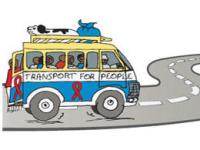 Credit: The World Bank
Credit: The World BankTransport corridors in sub-Saharan Africa, as elsewhere, enable movement of people and goods, increasing economic activity and spreading wealth. But they also facilitate the spread of HIV. In response, the Africa Transport Sector of the World Bank has published a practical new booklet on how to implement HIV prevention activities as part of road construction projects.
The booklet, The route to good living: An overview of roles and responsibilities for HIV prevention strategies in transport sector projects, shows just why this matters. Numerous studies find relatively high HIV prevalence in this sector, especially among long-distance truck drivers. Several have shown that truckers in Kenya, Rwanda and Uganda were more than twice as likely to be living with HIV as the general population.
Many transport workers spend weeks or months away from their families, and often have multiple sexual partners, which can facilitate the spread of HIV. In Nigeria, for example, one study documented each driver having more than six sexual partners at various stops along his route. This means that people living in and around major transport hubs also have increased vulnerability. In Kenya, along the Trans-Africa Highway, high risk behaviour has been reported among boys and girls visiting truck stops and incidence of sexually transmitted infections was documented in 50 percent of the girls and 30 percent of the boys.
 Credit: The World Bank
Credit: The World BankThe route to good living highlights practical steps that can be taken to prevent new infections among transport workers and roadside communities, with special emphasis on road construction works. It summarizes ‘do and don’ts’ for transport ministries, World Bank teams, contractors, consultants, country project units, donors and NGOs when designing and implementing such projects. An overview of the roles and responsibilities of each set of actors within the project cycle is provided: from identification to preparation to implementation and, finally, completion. An HIV prevention strategy should be not an afterthought but an integral part of the undertaking.
The booklet is the latest addition to the information and tools available on the World Bank Africa Transport Sector's AIDS web site.
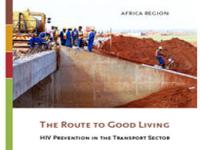 Promoting HIV prevention in the transport sector is a key component of the overall AIDS response
Promoting HIV prevention in the transport sector is a key component of the overall AIDS response Credit: The World Bank
It is the result of the sub-Saharan Africa Transport Policy Programme (SSATP) encouraging discussions and collaboration among a range of partners, including the Bank, to provide concrete support in dealing with HIV. The SSATP, a unique partnership of 35 countries, eight regional economic communities, three African institutions (including the African Union/New Partnership for Africa's Development) and international partners recognizes the importance of the transport sector in achieving its goals of reducing poverty and promoting economic growth and regional integration.
In order for the transport sector to fulfill its pivotal role, the potentially devastating effects of the AIDS epidemic must be effectively challenged. The route to good living provides a concrete guide to help achieve this goal
The route to good living: World Bank guide to HIV
Cosponsors:
World Bank’s AIDS work in Africa
Feature stories:
The AIDS response: Relationship to development in Africa (22 September 2008)
World Bank lays out new AIDS strategy for 2007-2011 (14 may 2008)
Tools:
More on the Sub-Saharan Africa Transport Policy Programme (SSATP)
Publications:
The route to good living: An overview of roles and responsibilities for HIV prevention strategies in transport sector projects (pdf, 716 Kb.)

